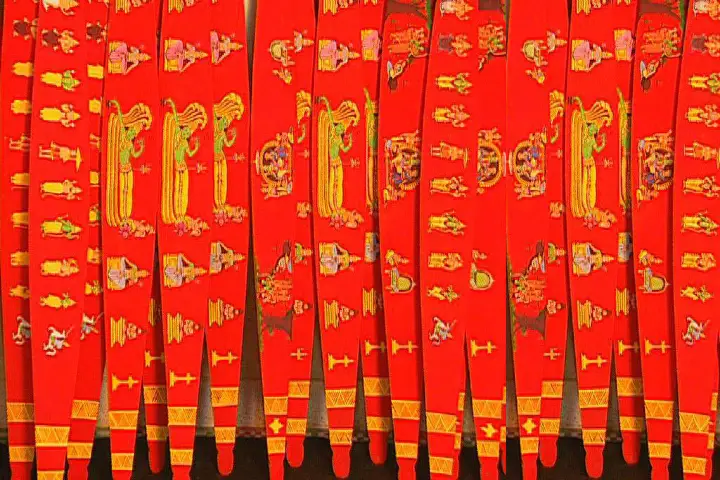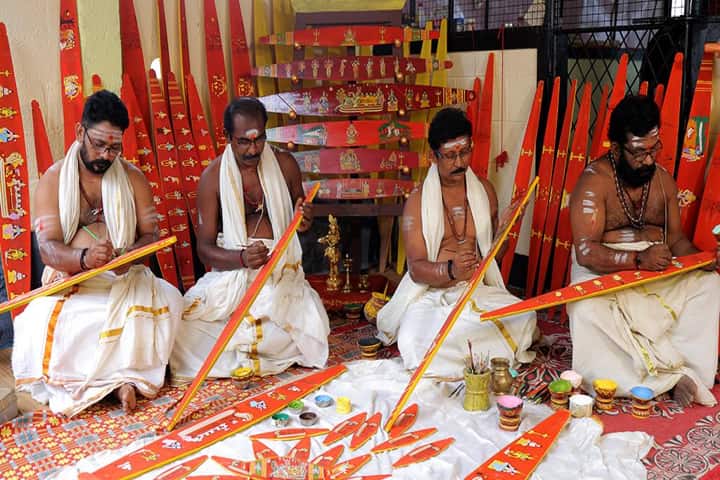A unique tradition of offering Onavillus or ceremonial bows to the deity of Sree Padmanabhaswamy Temple in Thiruvananthapuram, Kerala on Thiruvonam is observed during the Onam festival celebrations in Kerala. Thiruvonam this Onam falls on August 29 and it is considered as the most auspicious day during the annual harvest festival which is being celebrated from August 20 to 31.
Incidentally, a 40-minute documentary titled “Onavillu, The Divine Bow” in Hindi, Malayalam and English produced by Abhinav Kalra, will be released on the Jio Cinemas OTT on September 2 on this tradition that can be traced back to time immemorial.
What is Onavillu?
Onavillus are colourful bows which are hand-painted and depict all the incarnations of Lord Vishnu the Preserver according to the Hindu religion, reflecting artistic grandeur and divinity.
These bows are made out of wood from kadambu or mahogany, considered favourite of Lord Vishnu and their size vary from 3.5 to 4.5 feet in length and four to six inches in width. There are six types of onavillus. These depict Ananthasayanam that portrays Sree Padmanabhaswamy or Lord Vishnu on his serpent-bed and others; the ten incarnations of the Lord or Dasavatharam; Sree Krishna Leela or His dance with the gopikas; and the coronation of Lord Rama or Sree Rama Pattabhishekam; Sree Dharmasastha villu for Lord Sastha and Vinayaka for Lord Ganesha. Each of them is of different sizes and shapes.
The smallest ones are Sree Krishna Leela and Vinayaka and these are 3.5 feet long and four inches wide while the longest are Ananthasayanam and Dasavatharam – 4.5 feet long and six inches wide.

The villu is bow-shaped to resemble the State of Travancore which is also known as vanchinad due to its boat-like shape.
The bows showcase the Dravidian painting style, and are made using only five colours or the panchavarna. These are white, green, red, yellow, and black. Apart from this, these bows are decorated with red tassels.
Story of the divine bow
The Onavillu tradition has an interesting lore behind it as it is linked to King Mahabali who during the Onam festival returns from the nether world to meet his subjects in Kerala. According to mythology, when Vamana avatar of Lord Vishnu which denotes his dwarf incarnation was about to push Mahabali to the nether world, the King asked Lord Vishnu to show him all His divine incarnations. Lord Vishnu agreed but these incarnations could only be seen as paintings. Thus, God instructed Vishvakarma, the celestial architect to draw the incarnations in their actual forms for Mahabali.
Vishvakarma assured that his successors will continue to make these villus and offer them to Lord Padmanabhaswamy.
Many suggest that Onavillu could be one of the oldest temple rituals in Kerala and some believe that it is as old as the Padmanabhaswamy temple itself. Interestingly, the Onavillu tradition was briefly stopped but reintroduced in 1424 AD during the reign of Veera Iravi Varma.
Vilayil Veedu family
Another significant aspect of this custom of bow offering is that these are made by a particular family who reside at their ancestral house, Vilayil Veedu at Karamana in Thiruvananthapuram. Known as the Karamana Melarannoor Vilayil Veedu family, they are the only one entrusted with this task. The family occupied a significant position in the Sree Padmanabhaswamy temple and were the Vastu experts associated with this place of worship.
Travancore’s king Marthanda Varma in 1731 renovated the temple and at that time Anandapadmanabham Moothasari of Vilayil Veedu was the Sthapathy or master builder of the temple. A small sculpture of the Moothasari is there at the eastern entrance of the temple.
Following the age-old custom, the family makes six pairs of Onavillus and on Thiruvonam day offers them to Lord Padmanabhaswamy. The journey till here is a long one. It commences with seeking permission from mother nature, animals and birds to chop the kadambu tree. Now of course the wooden planks are sourced but the ritual continues. These are cut to shape and polished with sandpaper to apply colour and do the art work. Natural ingredients are used for colours like charcoal and turmeric powder.
Considering the reverence and divinity attached to these offerings, the family members who make them observe a number of rituals and restrictions. They observe 41 days of penance before starting the artwork. No, wonder the offerings reflect the brilliant craftsmanship and their utmost dedication.
The Onavillus are also purchased by many families for worshipping at home. These are considered to bring prosperity, peace and happiness to its worshippers.
Also read: Green lung of Kerala’s capital, the 165 years old Trivandrum Golf Club is steeped in history




















